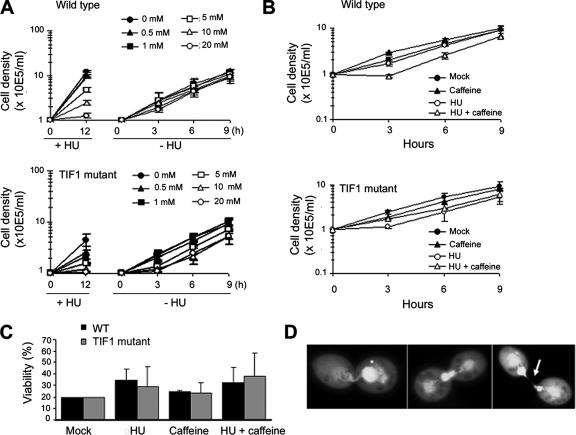Figure 5.
Response of wild-type and tif1-1::neo mutants to HU and caffeine. (A) Wild-type (CU428) and tif1-1::neo/TIF1 mutant (TXh48) strains were grown to a density of 3 × 104/ml and incubated for 12 h in growth media containing a range of HU concentrations (0–20 mM, +HU; stock solution in water) to induce S-phase–specific cell cycle arrest. Outgrowth of cultures after removal of the drug (−HU), refed cells were adjusted to a density of 1 × 105/ml and counted at 3-h intervals. The mean and SEs for three experiments are shown. (B) Outgrowth of cultures treated for 12 h with 20 mM HU and/or 0.3 mM caffeine (stock solution in water) and released into drug-free media. Cell densities were adjusted to 1 × 105/ml after washing out the drug(s), and the cultures were counted at 3-h intervals. The mean and SE for two experiments are shown. (C) Cell viability analysis in cultures treated with HU and/or caffeine. Wild-type and TIF1-deficient strains were incubated for 12 h in media containing no drug, 0.3 mM caffeine, 20 mM HU, or both. Cells were washed repeatedly to remove the drugs and plated out at decreasing concentrations into two 96-well dishes/dilution. For comparative analysis, the percentage of wells that was positive for growth in mock-treated cultures (plating density 0.3 cells/well) was normalized to 20 for each of the three experiments. The representative data for drug-treated strains were similarly normalized and correspond to the mean and SE of the three experiments. (D) Examples of macronuclear division defects in wild-type cells treated for 12 h with 20 mM HU and 0.3 mM caffeine and then propagated for 7 h in drug-free media.

